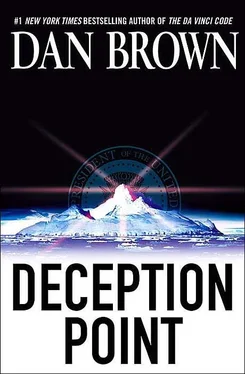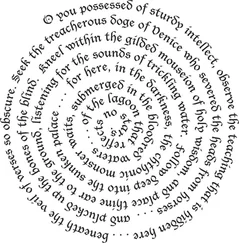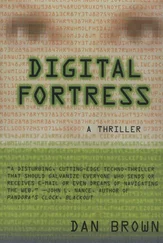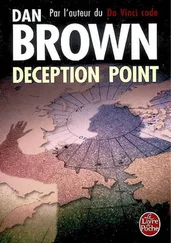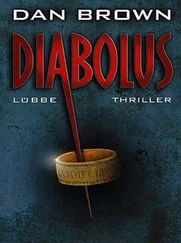“No, we don’t know,” Corky said.
Tolland shrugged. “Rise to the surface.”
“Terrific. So glad you had us aboard.”
Xavia entered carrying some papers. “Admiring the megaplume?”
“Oh, yes,” Corky said sarcastically. “Mike was just telling us how if that little mound ruptures, we all go spiraling around in a big drain.”
“Drain?” Xavia gave a cold laugh. “More like getting flushed down the world’s largest toilet.”
* * *
Outside on the deck of the Goya , the Coast Guard helicopter pilot vigilantly watched the EMS radar screen. As a rescue pilot he had seen his share of fear in people’s eyes; Rachel Sexton had definitely been afraid when she asked him to keep an eye out for unexpected visitors to the Goya.
What kind of visitors is she expecting? he wondered.
From all the pilot could see, the sea and air for ten miles in all directions contained nothing that looked out of the ordinary. A fishing boat eight miles off. An occasional aircraft slicing across an edge of their radar field and then disappearing again toward some unknown destination.
The pilot sighed, gazing out now at the ocean rushing all around the ship. The sensation was a ghostly one—that of sailing full speed despite being anchored.
He returned his eyes to the radar screen and watched. Vigilant.
Onboard the Goya , Tolland had now introduced Xavia and Rachel. The ship’s geologist was looking increasingly baffled by the distinguished entourage standing before her in the hydrolab. In addition, Rachel’s eagerness to run the tests and get off the ship as fast as possible was clearly making Xavia uneasy.
Take your time, Xavia, Tolland willed her. We need to know everything.
Xavia was talking now, her voice stiff. “In your documentary, Mike, you said those little metallic inclusions in the rock could form only in space.”
Tolland already felt a tremor of apprehension. Chondrules form only in space. That’s what NASA told me.
“But according to these notes,” Xavia said, holding up the pages, “that’s not entirely true.”
Corky glared. “Of course it’s true!”
Xavia scowled at Corky and waved the notes. “Last year a young geologist named Lee Pollock out of Drew University was using a new breed of marine robot to do Pacific deepwater crust sampling in the Mariana Trench and pulled up a loose rock that contained a geologic feature he had never seen before. The feature was quite similar in appearance to chondrules. He called them ‘plagioclase stress inclusions’—tiny bubbles of metal that apparently had been rehomogenized during deep ocean pressurization events. Dr. Pollock was amazed to find metallic bubbles in an ocean rock, and he formulated a unique theory to explain their presence.”
Corky grumbled. “I suppose he would have to.”
Xavia ignored him. “Dr. Pollock asserted that the rock formed in an ultradeep oceanic environment where extreme pressure metamorphosed a pre-existing rock, permitting some of the disparate metals to fuse.”
Tolland considered it. The Mariana Trench was seven miles down, one of the last truly unexplored regions on the planet. Only a handful of robotic probes had ever ventured that deep, and most had collapsed well before they reached the bottom. The water pressure in the trench was enormous—an astounding eighteen thousand pounds per square inch, as opposed to a mere twenty-four pounds on the ocean’s surface. Oceanographers still had very little understanding of the geologic forces at the deepest ocean floor. “So, this guy Pollock thinks the Mariana Trench can make rocks with chondrulelike features?”
“It’s an extremely obscure theory,” Xavia said. “In fact, it’s never even been formally published. I only happened to stumble across Pollock’s personal notes on the Web by chance last month when I was doing research on fluid-rock interactions for our upcoming megaplume show. Otherwise, I never would have heard of it.”
“The theory has never been published,” Corky said, “because it’s ridiculous. You need heat to form chondrules. There’s no way water pressure could rearrange the crystalline structure of a rock.”
“Pressure,” Xavia fired back, “happens to be the single biggest contributor to geologic change on our planet. A little something called a metamorphic rock? Geology 101?”
Corky scowled.
Tolland realized Xavia had a point. Although heat did play a role in some of earth’s metamorphic geology, most metamorphic rocks were formed by extreme pressure. Incredibly, rocks deep in the earth’s crust were under so much pressure that they acted more like thick molasses than solid rock, becoming elastic and undergoing chemical changes as they did. Nonetheless, Dr. Pollock’s theory still seemed like a stretch.
“Xavia,” Tolland said. “I’ve never heard of water pressure alone chemically altering a rock. You’re the geologist, what’s your take?”
“Well,” she said, flipping through her notes, “it sounds like water pressure isn’t the only factor.” Xavia found a passage and read Pollock’s notes verbatim. “‘Oceanic crust in the Mariana Trench, already under enormous hydrostatic pressurization, can find itself further compressed by tectonic forces from the region’s subduction zones.’“
Of course, Tolland thought. The Mariana Trench, in addition to being crushed under seven miles of water, was a subduction zone—the compression line where the Pacific and Indian plates moved toward one another and collided. Combined pressures in the trench could be enormous, and because the area was so remote and dangerous to study, if there were chondrules down there, chances of anyone knowing about it were very slim.
Xavia kept reading. “‘Combined hydrostatic and tectonic pressures could potentially force crust into an elastic or semiliquid state, allowing lighter elements to fuse into chondrulelike structures thought to occur only in space.’“
Corky rolled his eyes. “Impossible.”
Tolland glanced at Corky. “Is there any alternative explanation for the chondrules in the rock Dr. Pollock found?”
“Easy,” Corky said. “Pollock found an actual meteorite. Meteorites fall into the ocean all the time. Pollock would not have suspected it was a meteorite because the fusion crust would have eroded away from years under the water, making it look like a normal rock.” Corky turned to Xavia. “I don’t suppose Pollock had the brains to measure the nickel content, did he?”
“Actually, yes,” Xavia fired back, flipping through the notes again. “Pollock writes: ‘I was surprised to find the nickel content of the specimen falling within a midrange value not usually associated with terrestrial rocks.’“
Tolland and Rachel exchanged startled looks.
Xavia continued reading. “‘Although the quantity of nickel does not fall within the normally acceptable midrange window for meteoritic origin, it is surprisingly close.’“
Rachel looked troubled. “How close? Is there any way this ocean rock could be mistaken for a meteorite?”
Xavia shook her head. “I’m not a chemical petrologist, but as I understand it, there are numerous chemical differences between the rock Pollock found and actual meteorites.”
“What are those differences?” Tolland pressed.
Xavia turned her attention to a graph in her notes. “According to this, one difference is in the chemical structure of the chondrules themselves. It looks like the titanium/zirconium ratios differ. The titanium/zirconium ratio in the chondrules of the ocean sample showed ultradepleted zirconium.” She looked up. “Only two parts per million.”
Читать дальше
